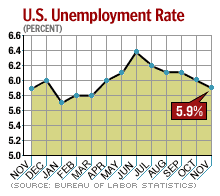NEW YORK (CNN/Money) -
U.S. job-cut announcements dipped in December, according to a report Tuesday by an outplacement firm, adding another brush stroke to a mixed picture of the long-suffering labor market.
While many economists see such reports as signs that more jobs are on the horizon, others worry structural changes in the economy will keep job growth muted.

U.S. businesses announced 93,020 job cuts in December, down 6.5 percent from 99,452 in November, according to Chicago-based Challenger, Gray & Christmas, which keeps track of monthly job-cut announcements.
December's announcements slightly exceeded those of December 2002, when 92,917 cuts were announced. There were 364,346 announcements in the fourth quarter, making it the largest job-cut quarter of 2003. The first quarter had the second-most cuts, with 355,795.
There were 1,236,426 job-cut announcements in all of 2003, down 16 percent from 1,466,823 in 2002.
| Related stories
|

|
|
|
|
"The decline in job cuts is certainly welcome news, but it is difficult to get too excited about a year in which more than 1.2 million people fell victim to downsizing," said John Challenger, the firm's CEO. "That is more than double the 553,044 job cuts averaged annually during the six-year period before the recession."
Industrial goods makers led the job cutting in December, announcing 12,039 cuts, according to Challenger. Computer firms announced 10,496 cuts, telecommunications firms announced 8,740 and consumer products makers announced 7,303.
For the full year, government and non-profit employers announced the most cuts, with 177,215, followed by telecommunications, which announced 111,342. It was the first time in three years that telecommunications did not lead all other industries.
Looking to Friday's jobs report
On Friday, the Labor Department is scheduled to release data on the December unemployment rate and growth in non-farm payrolls. Economists, on average, expect unemployment to hold steady at 5.9 percent and non-farm payrolls to grow by 148,000 jobs, according to Briefing.com.
Though unemployment is typically a lagging economic indicator, the U.S. economy has enjoyed eight straight quarters of economic growth, including a growth rate of 8.2 percent in the third quarter of 2003, without significant job creation.
In fact, since the declared end of the latest recession in November 2001, nearly 800,000 payroll jobs have been lost, according to the Labor Department. That would make this recovery period the most "jobless" since World War II.
But several indicators have lately pointed to labor-market improvement, including:
- A steady decline in the number of new weekly claims for unemployment benefits;
- A jump in the Institute for Supply Management's manufacturing employment index in December;
- A gain in first-quarter hiring intentions in the latest survey by Manpower Inc., a private research firm; and
- An increase in help-wanted advertising, as measured by the Help Wanted index of the Conference Board, another private research firm.
"It generally takes a few months after GDP growth such as we saw in the third quarter before that turns into strong growth in employment," said David Kelly, senior economist at Putnam Investments.
Structural changes in job market?
But there have been other signs that the labor market isn't fully healed, in addition to recent gains in job-cut announcements:
- The number of people drawing unemployment benefits for more than a week rose at the end of 2003 to the highest level in four months;
- The percentage of people in the Conference Board's monthly consumer confidence survey who say jobs are "hard to get" has stayed near the highest level in a decade; and
- Small business hiring intentions shrank in November, the latest data available, according to the National Federation of Independent Business.
Some economists worry that structural changes in the job market, including technological advances and a growing appetite for cheap offshore labor, will keep hiring growth muted in 2004.
"These ... factors are going to keep hiring from taking off in 2004," Challenger said. "Job seekers certainly should not expect to see a repeat of the tremendous job expansion of the mid-to-late 1990s."
Challenger suggested the next such hiring boom might not be seen until at least 2008.
Other economists disagree, however, saying productivity gains and labor globalization can co-exist with long-run growth in U.S. jobs, in part because they improve corporate profitability, enabling companies to expand business and develop new technologies.
"Although a heightened degree of overseas job outsourcing is probably taking place, the phenomenon is likely exaggerated by newspaper headlines; in any event, the net impact on aggregate employment is positive in the long run," Banc of America chief economist Mickey Levy said on Monday, adding that fears of workers being permanently replaced by technology has historically been "unwarranted."
Still, Levy said he expected non-farm payroll growth of just 140,000 jobs per month, just barely enough to keep up with the average monthly growth of the labor force -- meaning unemployment shouldn't fall much in 2004.

|

